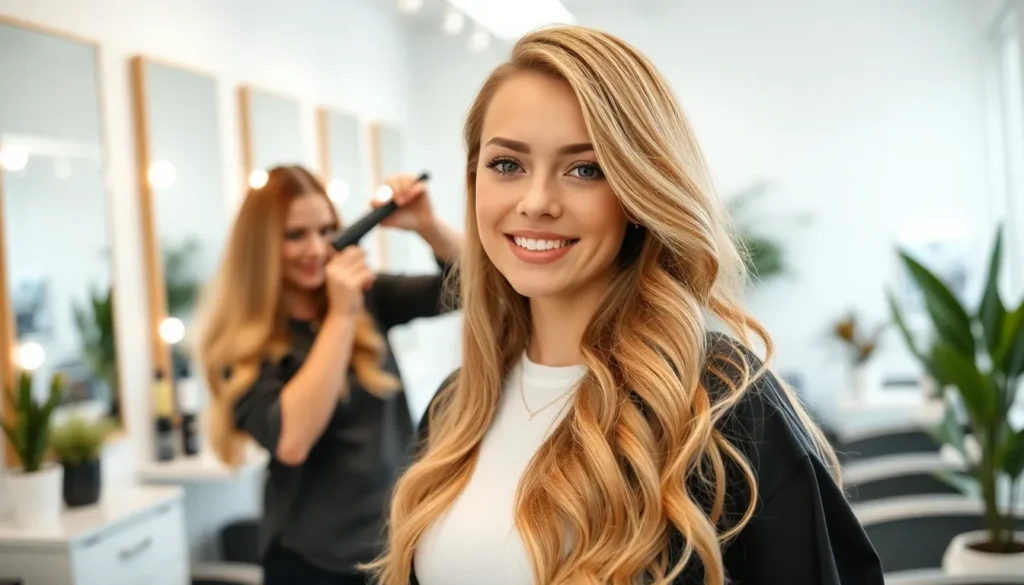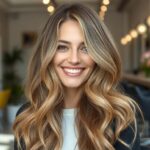We’ve all dreamed of that effortlessly sun-kissed blonde look that seems to capture light from every angle. Blonde balayage has become the ultimate hair color technique that delivers natural-looking highlights without the harsh lines of traditional foil methods.
This hand-painted coloring technique creates stunning dimensional blonde tones that blend seamlessly with your natural hair color. Unlike conventional highlighting methods blonde balayage offers a more organic appearance that grows out beautifully and requires less frequent touch-ups.
Whether you’re looking to add subtle warmth to your brunette base or transform into a full blonde goddess blonde balayage adapts to your unique style and maintenance preferences. We’ll explore everything you need to know about this game-changing color technique that’s taken the beauty industry by storm.
What Is Blonde Balayage and Why It’s the Perfect Hair Trend
Blonde balayage represents the perfect fusion of artistry and hair science, delivering stunning results that look effortlessly beautiful. We’ve seen this technique transform countless clients into radiant versions of themselves.
The Art of Hand-Painted Highlights
Hand painting defines the core of blonde balayage technique, allowing colorists to strategically place highlights exactly where natural sunlight would kiss your hair. We customize each stroke based on your face shape, skin tone, and desired level of brightness.
Professional colorists use specialized brushes to sweep lightener through selected sections, creating organic placement patterns that mirror natural hair lightening. This freehand approach eliminates the rigid sectioning patterns found in traditional highlighting methods.
Precision becomes crucial during the application process, as we carefully control the saturation and placement of each painted section. Master colorists spend years perfecting their brushwork to achieve seamless blending between highlighted and natural tones.
Creative freedom flourishes with this technique, enabling us to adapt the color placement to complement your unique features and lifestyle preferences. We can concentrate highlights around your face for brightening effects or distribute them throughout for all over dimension.
Natural Sun-Kissed Effect vs Traditional Foils
Sun kissed results emerge naturally with blonde balayage because we mimic how sunlight actually lightens hair over time. Traditional foils create uniform stripes that can look artificial and require frequent root touch ups every 6-8 weeks.
Balayage grows out gracefully, allowing 12-16 weeks between appointments because the hand painted placement creates softer regrowth lines. Foil highlights often show harsh demarcation lines at the roots, making maintenance schedules more demanding.
Dimensional depth develops through balayage’s varied tonal placement, while foiled highlights typically produce flatter, more uniform color results. We achieve multiple blonde shades within one service, creating natural looking movement and texture.
Customization options expand significantly with balayage since we aren’t restricted by foil placement limitations. Traditional foiling requires systematic sectioning that can’t adapt to individual hair growth patterns or face framing needs.
Cost effectiveness improves over time with balayage appointments, as the extended wear between services often balances the initial investment. Foil maintenance schedules can become expensive due to frequent root coverage requirements.
Choosing the Right Blonde Balayage Shade for Your Skin Tone
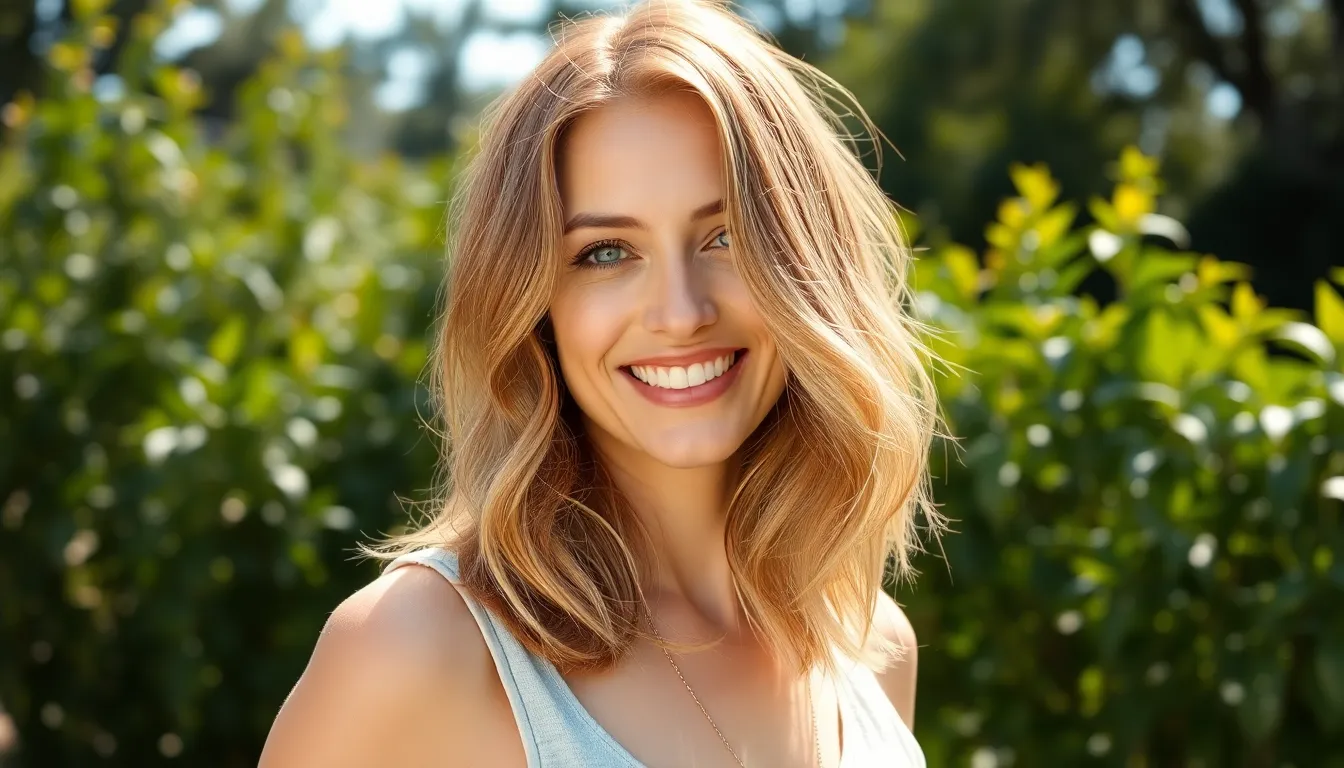
Selecting the perfect blonde balayage shade depends entirely on understanding your skin’s undertones. We’ll help you identify which blonde tones will enhance your natural beauty and create the most flattering results.
Warm Undertones: Honey and Caramel Blonde Balayage
Warm undertones call for golden blonde balayage shades that complement your natural radiance. Honey blonde creates a beautiful sun kissed glow that enhances the golden flecks in warm complexions. This shade works particularly well on medium to darker base colors, creating stunning contrast without looking too harsh.
Caramel blonde offers deeper warmth with rich amber tones that blend seamlessly with olive or golden skin. We recommend this shade for clients who want noticeable lightening while maintaining a natural appearance. Caramel balayage creates dimensional depth through varied golden tones that catch light beautifully.
Butterscotch and champagne blonde provide additional options for warm undertones, offering lighter alternatives while preserving the golden base. These shades create soft transitions from darker roots to lighter ends, perfect for first time balayage clients.
Cool Undertones: Ashy and Platinum Blonde Balayage
Cool undertones require ashy blonde balayage that neutralizes any unwanted warmth in the hair. Ashy blonde creates sophisticated, modern results by incorporating gray and silver tones that complement pink or blue based skin. This shade works exceptionally well on naturally light brown to medium blonde base colors.
Platinum blonde delivers the most dramatic cool toned results, creating striking contrast against cool complexions. We achieve this shade through multiple lightening sessions, making it ideal for clients committed to regular maintenance. Platinum balayage requires skilled application to prevent damage while achieving desired lightness levels.
Ice blonde and pearl tones offer subtle cool alternatives that provide dimension without extreme contrast. These shades incorporate silver highlights that enhance cool undertones while maintaining hair health through gentler lightening processes.
Neutral Undertones: Versatile Blonde Options
Neutral undertones enjoy the most flexibility in blonde balayage shade selection, working well with both warm and cool tones. Beige blonde creates the perfect balance between golden and ashy tones, complementing skin that doesn’t lean strongly warm or cool. This versatile shade adapts beautifully to different lighting conditions.
Sandy blonde offers natural looking results that mimic childhood hair colors for many clients with neutral undertones. We create this shade by blending warm and cool highlights throughout the hair, resulting in multidimensional blonde that appears effortlessly sun lightened.
Wheat blonde provides another excellent neutral option, combining golden warmth with cooler undertones for balanced results. This shade creates beautiful movement and depth while remaining low maintenance, making it perfect for busy lifestyles.
Preparing Your Hair for Blonde Balayage Success
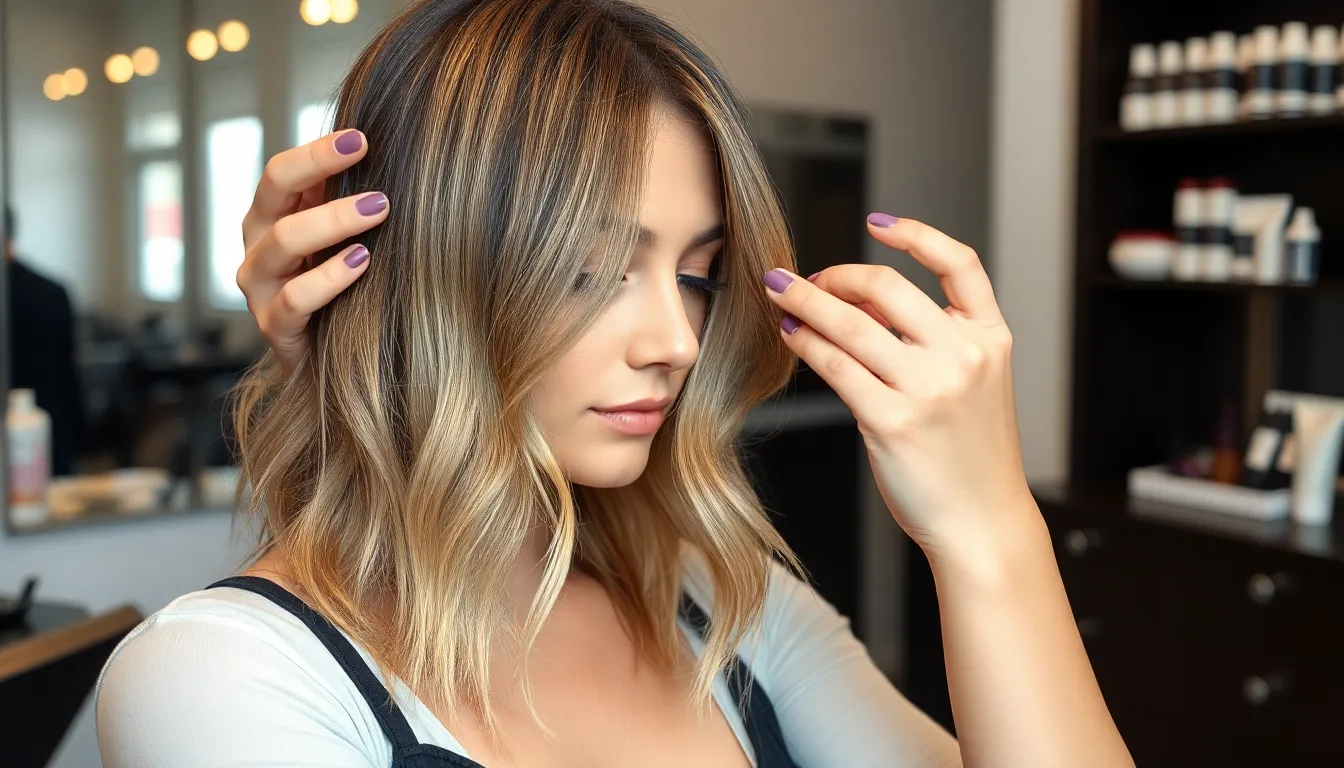
Success with blonde balayage starts with proper preparation and realistic expectations. We’ll walk you through the essential steps to ensure your hair is ready for this groundbreaking color technique.
Assessing Your Current Hair Color and Condition
Current hair color plays a crucial role in determining your blonde balayage timeline and results. We examine starting points from natural brunette to previously colored hair to create realistic expectations.
Natural brunette hair typically requires 2-3 sessions to achieve lighter blonde balayage shades safely. Dark hair contains more pigment that needs lifting, making the process gradual to maintain hair integrity.
Previously colored or chemically treated hair demands extra caution and professional assessment. We evaluate existing color molecules, processing history, and potential damage before proceeding with balayage application.
Hair texture influences processing time and technique selection significantly. Fine hair lifts faster but requires gentler formulations, while coarse hair needs stronger developers and longer processing periods.
Damage assessment determines feasibility of your desired blonde balayage look. We check for breakage, dryness, and elasticity to ensure hair can handle the lightening process without compromising health.
Pre-Treatment Steps for Healthy Results
Deep conditioning treatments should begin 2-3 weeks before your blonde balayage appointment. We recommend protein treatments for damaged hair and moisture masks for dry, brittle strands.
Clarifying shampoo removes product buildup that can interfere with color processing and create uneven results. Use clarifying treatments 3-5 days before your appointment to ensure clean application.
Heat styling should be minimized in the weeks leading up to balayage treatment. We suggest air drying and using heat protectants when styling tools are necessary to prevent additional damage.
Chemical services require proper timing to avoid compromising blonde balayage results. Schedule relaxers, perms, or other color treatments at least 4-6 weeks before or after balayage application.
Consultation appointments help establish realistic goals and treatment plans with your colorist. We discuss maintenance schedules, budget considerations, and styling preferences during these essential planning sessions.
Hair trimming removes damaged ends that could affect color uptake and overall appearance. Fresh cuts create cleaner lines and healthier foundations for blonde balayage application.
The Blonde Balayage Application Process Explained
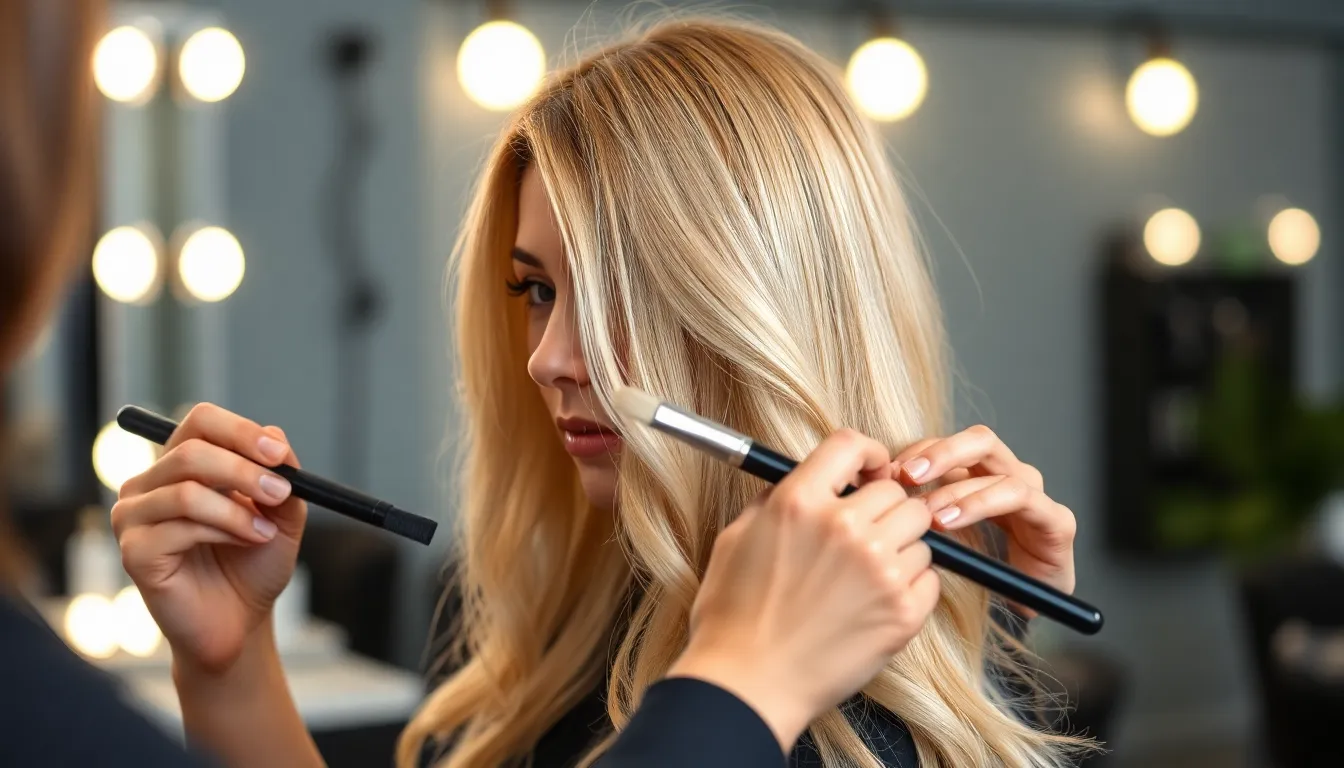
Professional colorists follow a precise application process that transforms your hair into stunning blonde balayage. We’ll walk you through each critical stage of this artistic technique.
Sectioning and Placement Techniques
Strategic sectioning creates the foundation for natural blonde balayage results. Colorists divide hair into horizontal sections starting from the nape, working upward in 1-2 inch increments to ensure even coverage and accessibility.
Diagonal weaving patterns distinguish balayage from traditional foil highlights. Professional stylists use a board or paddle underneath each section, applying lightener with brushes in V-shaped motions that create soft, feathered edges rather than harsh lines.
Surface highlighting focuses on the top layers where natural sunlight hits most. Colorists concentrate 60-70% of the lightener on the mid-lengths and ends, gradually increasing intensity toward the tips for that signature sun-kissed gradient effect.
Face framing pieces receive special attention during blonde balayage placement. Stylists strategically paint brighter highlights around the hairline and temples, creating dimension that enhances facial features and adds brightness to your complexion.
Lightening and Toning Stages
Bleaching powder mixed with developer creates the lightening foundation for blonde balayage. Professional colorists typically use 20-30 volume developer, adjusting strength based on your starting hair color and desired lift level for optimal results.
Multiple lightening sessions may be necessary for dramatic blonde transformations. Dark hair often requires 2-3 appointments spaced 6-8 weeks apart to safely achieve lighter blonde shades without compromising hair integrity or causing excessive damage.
Toning neutralizes unwanted brass and yellow tones after lightening. Colorists apply purple, blue, or ash-based toners to create the perfect blonde shade, whether you’re seeking icy platinum, warm honey, or neutral beige tones.
Color depth varies throughout the application for authentic blonde balayage dimension. Professionals create 2-4 different tonal levels within your highlights, blending seamlessly from your natural base color to the lightest blonde sections.
Processing Time and Professional Expertise
Processing times range from 30-90 minutes depending on your hair’s starting color and condition. Virgin hair typically lightens faster than previously colored hair, requiring careful monitoring every 10-15 minutes to achieve desired blonde levels safely.
Heat application can accelerate the lightening process during blonde balayage sessions. Many colorists use low heat from hair dryers or processing caps to speed development, reducing total appointment time by 15-30 minutes while maintaining gentle processing.
Professional colorists assess lift levels throughout the application process. Experienced stylists check sections every 20 minutes, looking for even lightening and optimal blonde development before proceeding to the toning stage.
Timing coordination ensures all sections reach proper blonde levels simultaneously. Skilled colorists stagger application by starting with the most resistant areas first, typically the back sections, then moving to more porous areas that process faster near the hairline and crown.
Maintaining Your Blonde Balayage Between Salon Visits
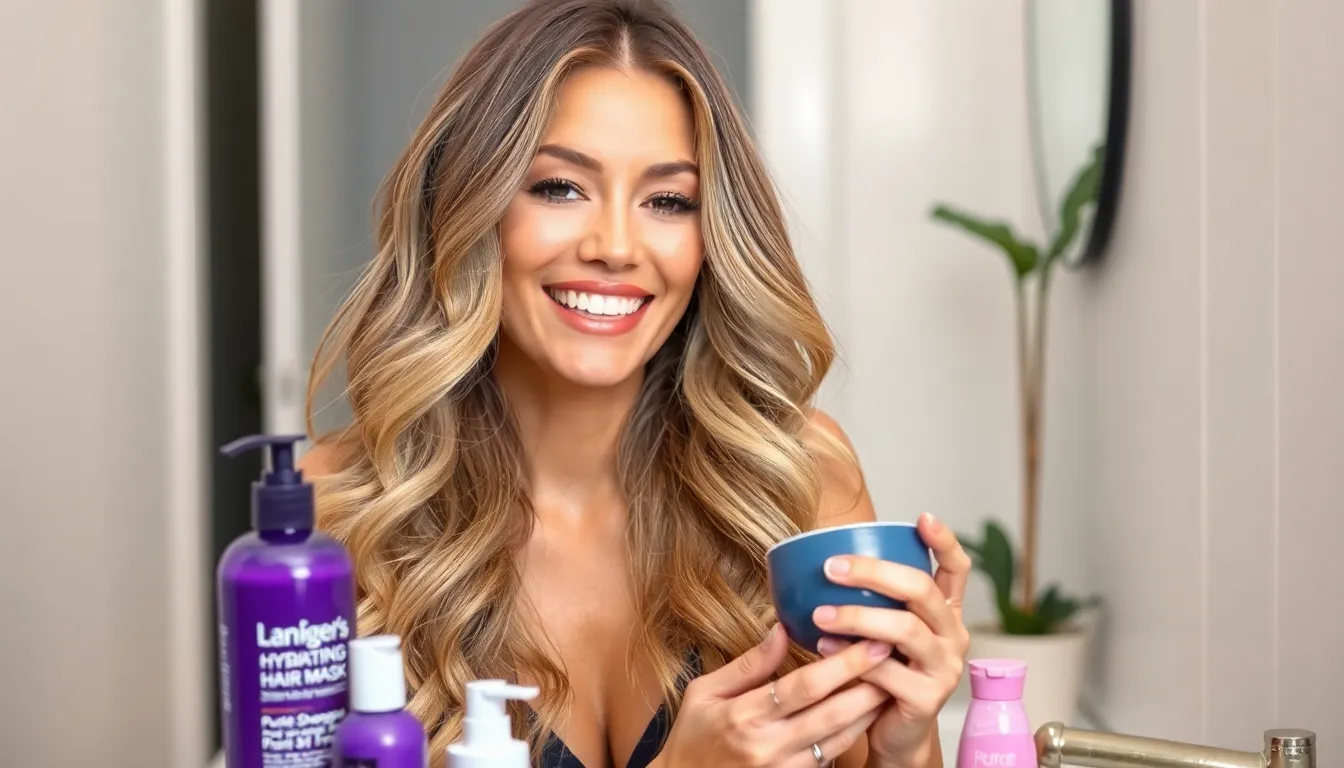
Proper at-home care keeps your blonde balayage looking vibrant and healthy for the full 12-16 weeks between professional appointments. We’ll share the essential maintenance strategies that preserve your investment and extend the life of your stunning color.
Essential Hair Care Products for Color Protection
Purple shampoo becomes your most important weekly ally in maintaining blonde balayage tones. We recommend using it 1-2 times per week to neutralize yellow and brassy undertones that naturally develop over time. Olaplex No. 3 or similar bond-building treatments should be applied weekly to strengthen hair weakened by the lightening process.
Color-safe shampoo and conditioner designed specifically for blonde hair protect your balayage from fading and environmental damage. Look for sulfate-free formulas that won’t strip your color or natural oils. Leave-in conditioner with UV protection shields your blonde tones from sun damage that can cause unwanted brassiness.
Dry shampoo extends the time between washes and prevents over-cleansing that leads to color fade. Choose clear or blonde-exact formulas to avoid dulling your highlights. Color-depositing masks in ash or platinum tones can refresh your balayage between salon visits when used monthly.
Weekly Deep Conditioning Treatments
Hydrating hair masks should be applied weekly to combat the drying effects of lightening chemicals on your blonde balayage. We suggest focusing application on mid-lengths and ends where color processing creates the most damage. Protein treatments used bi-weekly help rebuild the hair structure that bleaching can compromise.
Overnight conditioning treatments provide intensive moisture restoration for severely damaged blonde hair. Apply these deep conditioners to damp hair before bed and rinse in the morning for maximum penetration. Natural oils like argan or coconut can be used as pre-shampoo treatments to add extra nourishment to your balayage.
Steam treatments at home amplify the effectiveness of your deep conditioning routine. Simply cover your conditioner-coated hair with a shower cap and apply gentle heat from a blow dryer for 10-15 minutes. Alternating between moisture and protein treatments maintains the perfect balance your blonde balayage needs to stay healthy.
Heat Protection and Styling Tips
Thermal protection spray must be applied before any heat styling to prevent further damage to lightened hair. We recommend products with at least 400-degree heat protection for optimal blonde balayage care. Lower heat settings between 250-300 degrees protect your color while still achieving your desired style.
Air drying whenever possible reduces heat exposure and maintains your balayage’s natural texture and movement. When you do use heat tools, ceramic or titanium plates distribute temperature more evenly than cheaper alternatives. Silk pillowcases reduce friction that can cause breakage in fragile blonde hair.
Cool water rinses after shampooing seal the hair cuticle and lock in color molecules. Finish your styling routine with cold air from your blow dryer to add shine and reduce frizz. Regular trims every 6-8 weeks keep your blonde balayage looking fresh by removing damaged ends that can make color appear dull.
Cost Considerations for Blonde Balayage Services

Understanding the investment required for blonde balayage helps you plan your budget and maintain your desired look. Professional balayage services require careful consideration of both upfront costs and ongoing maintenance expenses.
Initial Investment and Touch-Up Frequency
Initial balayage sessions typically range from $150 to $400, depending on your salon’s location and the complexity of your desired transformation. First-time clients often require 2-3 hours in the chair, especially when lightening darker hair significantly. Stylists must work methodically to achieve even coverage and proper color development throughout the process.
Touch-up appointments occur every 12-16 weeks, making balayage more cost-effective than traditional highlights requiring 6-8 week intervals. Root touch-ups generally cost $100 to $250, depending on how much new growth needs attention. Maintenance sessions focus on refreshing the blonde tones and blending any visible regrowth lines.
Annual balayage costs average $600 to $1,200 when factoring in initial application and quarterly maintenance visits. This investment includes professional color services, toning treatments, and occasional gloss applications. Many clients find this schedule more manageable than frequent foil highlight appointments.
Factors That Affect Pricing
Geographic location significantly impacts balayage pricing, with major metropolitan areas charging premium rates compared to smaller towns. Urban salons in cities like New York and Los Angeles often charge 30-50% more than suburban locations. Coastal regions typically command higher prices due to increased demand and operating costs.
Stylist experience level directly correlates with service pricing, as master colorists charge $50-100 more per session than junior stylists. Specialists with advanced balayage certifications often justify higher rates through superior technique and color knowledge. Celebrity stylists or salon owners frequently charge premium prices for their expertise.
Hair length and thickness determine processing time and product usage, affecting overall service costs. Longer hair requires more bleach, toner, and developer, increasing material expenses by 20-30%. Thick hair textures need additional sectioning and processing time, extending appointment duration and associated fees.
| Length Category | Processing Time | Typical Price Range |
|---|---|---|
| Short (above shoulders) | 2-2.5 hours | $150-$250 |
| Medium (shoulder to mid-back) | 2.5-3 hours | $200-$350 |
| Long (below mid-back) | 3-4 hours | $300-$400 |
Starting hair color affects lightening requirements and session complexity, with darker bases requiring more processing steps. Virgin hair lifts more predictably than previously colored hair, reducing potential complications and processing time. Damaged or chemically treated hair may need multiple sessions, increasing overall investment costs.
Common Blonde Balayage Mistakes to Avoid

Even experienced colorists can encounter pitfalls that compromise blonde balayage results. Understanding these common mistakes helps ensure we achieve stunning, healthy blonde tones.
Over-Processing and Damage Prevention
Lifting hair too quickly creates the most damaging blonde balayage mistake we encounter in salons. Attempting to reach platinum blonde in a single session often leads to severe breakage and compromised hair integrity. Professional colorists recommend multiple sessions spaced 6-8 weeks apart for dramatic color transformations.
Skipping strand tests before full application can result in unexpected color outcomes and damage. We always perform small test sections to determine processing times and final color results. These preliminary tests reveal how our hair responds to exact developer strengths and processing durations.
Using developers that are too strong accelerates processing but increases damage risk exponentially. Volume 20 developer works effectively for most blonde balayage applications, while volume 30 should only be used on dark virgin hair. Higher volumes like 40 create unnecessary stress on hair cuticles.
Overlapping previously lightened sections during touch-up appointments causes severe breakage at overlap points. Experienced colorists carefully map previous placement patterns and apply new color only to regrowth areas. This technique preserves hair health while maintaining seamless color transitions.
Choosing the Wrong Colorist
Selecting colorists based solely on price often leads to disappointing blonde balayage results and potential hair damage. Experienced balayage specialists invest years perfecting their hand-painting techniques and understanding color theory. Budget-friendly options may lack the expertise needed for complex blonde transformations.
Overlooking portfolio quality when choosing a colorist can result in mismatched expectations and poor outcomes. We recommend reviewing recent work that specifically showcases blonde balayage on similar hair types and textures. Instagram portfolios and salon websites provide excellent examples of a colorist’s skill level.
Ignoring consultation processes signals potential issues with communication and technique understanding. Professional colorists conduct thorough consultations to assess hair history, desired outcomes, and maintenance commitments. Rushed consultations often lead to unrealistic expectations and subpar results.
Trusting inexperienced technicians with advanced blonde balayage techniques frequently results in uneven placement and color inconsistencies. Master colorists typically require 3-5 years of specialized training to perfect balayage hand-painting methods. Certification programs and continuing education demonstrate a colorist’s commitment to excellence.
Styling Your Blonde Balayage for Maximum Impact
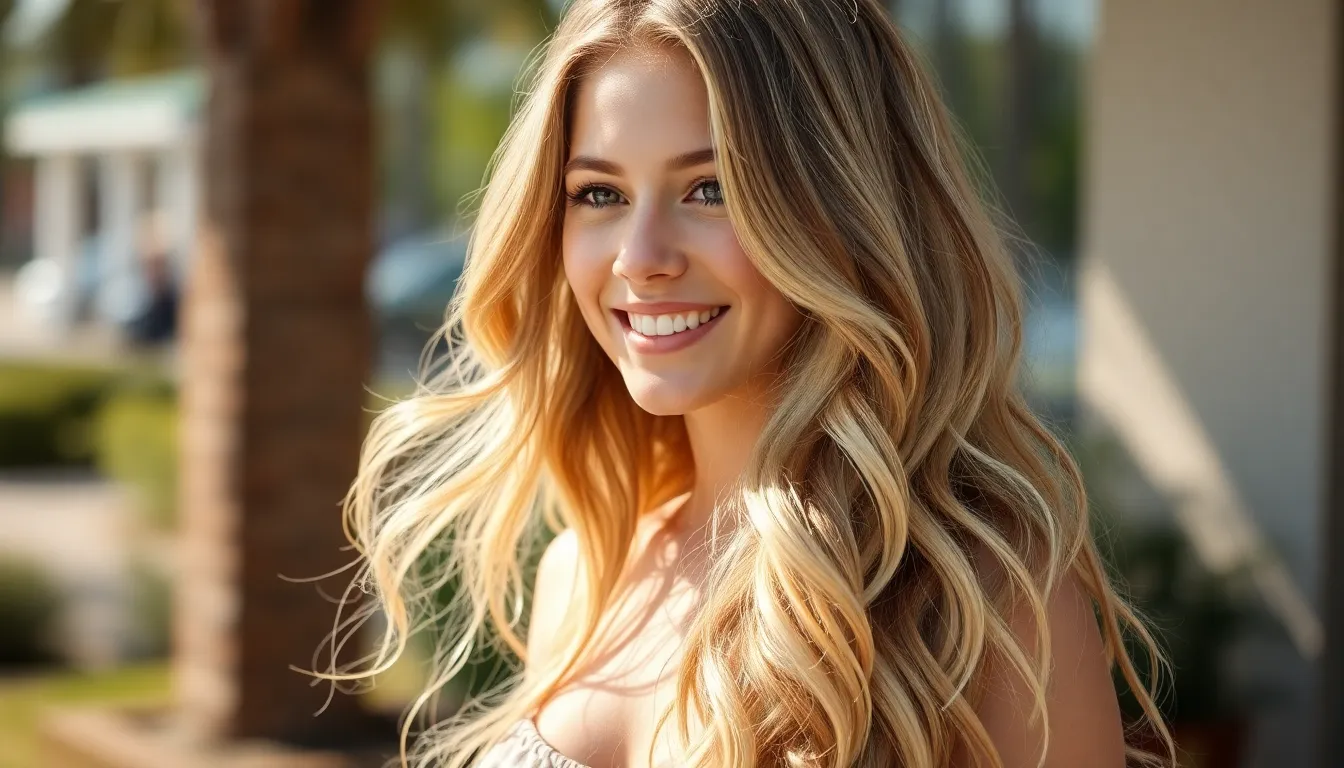
After investing in your perfect blonde balayage, you’ll want to showcase those dimensional tones through strategic styling choices. The key is selecting techniques that highlight the color placement and enhance the natural flow of your balayage.
Beachy Waves and Effortless Textures
Beachy waves remain the gold standard for displaying blonde balayage because they mirror the natural movement created during the hand painting process. We recommend using a sea salt spray on damp hair to enhance natural texture and create definition between the darker and lighter sections. Scrunching your hair while it air dries allows the different blonde tones to separate organically, creating depth and movement.
Loose curls created with a 1.5 inch curling iron showcase the dimensional placement beautifully. Start by curling random sections away from your face, leaving the ends out for a modern finish. This technique allows the lighter balayage pieces to catch light at different angles, maximizing the sun kissed effect you’ve achieved.
Braided textures work exceptionally well with blonde balayage by creating interesting patterns with the color placement. Try a loose side braid or multiple small braids that you sleep in overnight for gentle waves. The varying blonde tones create visual interest as they weave through the textured style, emphasizing the multidimensional aspect of your color.
Texturizing products like volumizing mousse and dry shampoo help separate the different blonde shades while adding body to your style. Apply these products to damp hair before styling to enhance the natural variation in your balayage placement.
Sleek Styles That Showcase Dimension
Sleek styling techniques reveal the precise artistry of your blonde balayage placement by creating clean lines that display color transitions. We suggest using a high quality heat protectant before blow drying your hair straight with a paddle brush to achieve maximum smoothness. This creates a mirror like surface that reflects light beautifully across your blonde tones.
Flat ironing in small sections at moderate temperatures allows you to see every nuance of color placement without causing damage. Focus on keeping the iron moving consistently to avoid hot spots while creating that glossy finish that makes blonde balayage appear more vibrant.
Slicked back styles using lightweight oils or serums create stunning contrast between darker roots and lighter ends. Pull your hair into a low ponytail or bun while the product is still wet to maintain that sleek finish. This styling choice emphasizes the gradual color transition that makes balayage so appealing.
Center parts work particularly well with sleek blonde balayage because they create symmetry that showcases the color placement on both sides of your head. Use a fine tooth comb to create a precise part, then smooth each side with your hands and a small amount of shine serum.
Glass hair techniques using smoothing treatments and high shine products make blonde balayage appear more expensive and professionally done. Apply a glossing serum from mid length to ends, avoiding the root area to prevent weighing down your hair while maximizing the reflective quality of your blonde tones.
Celebrity Blonde Balayage Inspiration
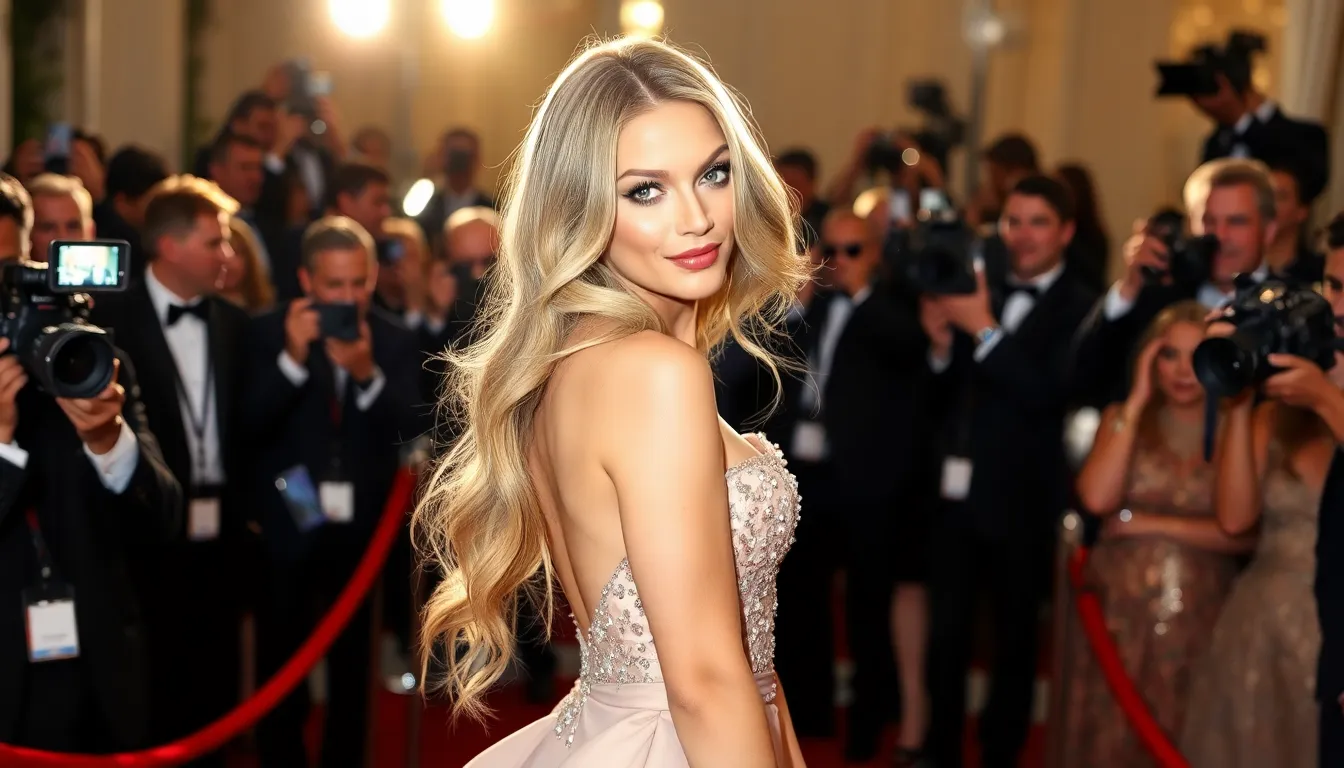
Red carpet events showcase the most stunning blonde balayage transformations that inspire countless salon visits worldwide. These celebrity looks demonstrate the versatility and elegance of expertly crafted balayage techniques.
Red Carpet Looks and Trending Styles
Blake Lively’s sun-kissed masterpiece remains the gold standard for blonde balayage inspiration. Her colorist creates seamless honey tones that transition from darker roots to lighter ends, achieving that coveted beachy California look. This style works particularly well for medium to long hair lengths and requires strategic placement around the face for maximum impact.
Margot Robbie’s platinum perfection showcases how balayage can achieve ultra-light tones without harsh demarcation lines. Her stylist uses a combination of baby lights and traditional balayage to create multi-dimensional brightness. The technique involves painting fine sections throughout the hair rather than concentrating highlights in exact areas.
Jennifer Aniston’s caramel cascade demonstrates the power of warm blonde tones in balayage application. Her colorist blends rich caramel shades with lighter champagne highlights to create depth and movement. This approach works exceptionally well for those wanting to lighten their hair gradually while maintaining natural-looking results.
Scarlett Johansson’s ash blonde evolution proves that cool-toned balayage can be equally stunning on the red carpet. Her stylist incorporates platinum and ash tones to neutralize any yellow undertones while creating striking contrast. The technique requires expert toning to achieve the perfect balance between cool and warm elements.
Adapting Celebrity Colors to Your Features
Face shape considerations play a crucial role when adapting celebrity balayage looks to your unique features. Round faces benefit from lighter pieces placed around the perimeter to create elongating effects, while square faces need softer highlighting patterns to minimize angular features. Our stylists recommend concentrating highlights around the cheekbones and temple areas for the most flattering results.
Skin tone matching ensures your celebrity-inspired balayage complements rather than competes with your natural coloring. Warm undertones pair beautifully with Blake Lively’s honey tones, while cool undertones shine with Scarlett Johansson’s ash blonde palette. Those with neutral undertones can experiment with both warm and cool balayage variations depending on their personal style preferences.
Hair texture modifications help achieve celebrity looks regardless of your natural hair type. Fine hair requires more concentrated highlighting to create visible dimension, while thick hair can handle broader sweeps of color. Curly hair showcases balayage beautifully when highlights follow the natural curl pattern, creating organic movement and depth.
Lifestyle adaptations make celebrity balayage more practical for everyday wear. We recommend discussing maintenance requirements with your colorist to determine which celebrity look aligns with your styling routine. Some red carpet looks require daily styling and frequent touch-ups, while others maintain their beauty with minimal effort.
Transitioning from Other Hair Colors to Blonde Balayage
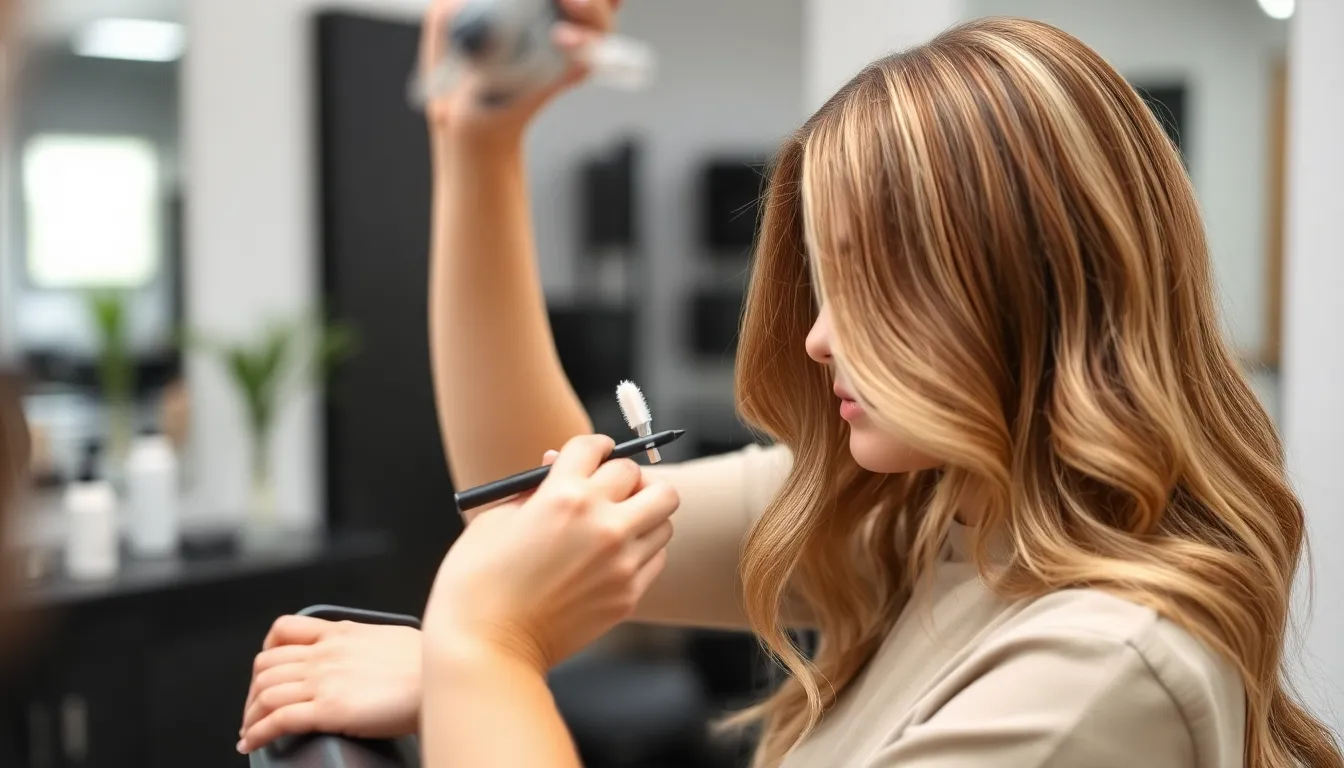
Transitioning to blonde balayage from other hair colors requires strategic planning and professional expertise to achieve stunning results. We’ll guide you through the essential considerations for making this dramatic change safely and effectively.
From Brunette to Blonde Gradual Process
Brunette hair needs multiple sessions to achieve blonde balayage without compromising hair integrity. We recommend spacing appointments 6-8 weeks apart to allow your hair to recover between lightening sessions.
Session breakdown typically follows this pattern:
| Session | Lightening Level | Expected Results | Processing Time |
|---|---|---|---|
| First | 2-3 levels | Subtle caramel highlights | 2-3 hours |
| Second | 3-4 levels | Honey blonde tones | 3-4 hours |
| Third | 4-5 levels | Full blonde balayage | 3-5 hours |
Starting with darker brown hair requires patience as we gradually lift pigment to prevent breakage. Your colorist will assess your hair’s porosity and elasticity before each session to determine safe lightening limits.
Deep conditioning treatments between sessions become essential for maintaining hair health during this transformation. We suggest scheduling these treatments 2 weeks after each lightening appointment to restore moisture and protein balance.
Virgin brunette hair responds more predictably than previously colored hair during the lightening process. Colorists can achieve faster results on untreated hair while maintaining structural integrity throughout the transition.
Color Correction Considerations
Previous color treatments significantly impact your blonde balayage journey and may require specialized correction techniques. We evaluate existing color buildup, metallic deposits, and damage levels before beginning any lightening process.
Common correction scenarios include:
- Box dye removal: Requires gentle stripping agents and extended processing times
- Brass neutralization: Needs multiple toning sessions with violet based products
- Red undertone elimination: Involves green based toners and careful timing
- Uneven color patches: Demands spot treatments and strategic placement adjustments
Color wheels become our roadmap for neutralizing unwanted tones during the correction phase. Opposite colors on the wheel cancel each other out, helping us achieve clean blonde results.
Strand testing proves crucial when working with previously colored hair to predict final outcomes. We perform these tests 48 hours before your appointment to avoid unexpected reactions or damage.
Protein treatments may be necessary between correction sessions if your hair shows signs of overprocessing. Signs include excessive stretching when wet, unusual porosity, or breakage during gentle manipulation.
Professional color removers work more effectively than home remedies for stubborn artificial pigments. These products require expert application and precise timing to avoid compromising your hair’s structural integrity.
Patience becomes your greatest asset during color correction as rushing the process often leads to damage or unsatisfactory results. We prioritize hair health over speed to ensure your blonde balayage looks beautiful and lasts longer.
Conclusion
Blonde balayage continues to reign as one of the most sought-after hair coloring techniques and for good reason. We’ve explored how this artful method delivers stunning sun-kissed results while offering flexibility that traditional highlighting simply can’t match.
The investment in professional blonde balayage pays dividends through reduced maintenance visits and healthier-looking hair. When you combine proper preparation with expert application and consistent aftercare your blonde balayage will remain vibrant and beautiful for months.
Whether you’re inspired by celebrity looks or creating your own signature style blonde balayage offers endless possibilities for customization. Trust the process work with experienced colorists and embrace the groundbreaking power of expertly crafted blonde balayage.
Frequently Asked Questions
What is blonde balayage and how does it differ from traditional highlights?
Blonde balayage is a hand-painted hair coloring technique that creates natural-looking, sun-kissed blonde highlights without harsh lines. Unlike traditional foil highlights that create uniform stripes, balayage mimics natural lightening patterns where sunlight would naturally hit your hair, resulting in a more organic, dimensional appearance with softer regrowth lines.
How often do I need touch-ups for blonde balayage?
Blonde balayage requires touch-ups every 12-16 weeks, making it more low-maintenance than traditional highlights. The hand-painted technique creates softer regrowth lines that blend naturally with your base color, allowing for longer intervals between salon appointments and making it more cost-effective over time.
Which blonde balayage shade works best for my skin tone?
Warm undertones pair beautifully with honey and caramel blonde shades, while cool undertones look stunning with ashy and platinum blonde tones. If you have neutral undertones, versatile options like beige, sandy, and wheat blonde provide the perfect balance between warm and cool tones for a naturally flattering result.
How much does blonde balayage cost?
Initial blonde balayage sessions typically range from $150 to $400, depending on your location, stylist experience, hair length, and starting color. Touch-up appointments every 12-16 weeks help maintain the look. While the initial investment may seem high, the extended time between appointments makes it cost-effective compared to traditional highlighting methods.
Can I get blonde balayage on previously colored hair?
Yes, but transitioning from other colors to blonde balayage requires professional expertise and strategic planning. Color correction may be necessary for previous treatments, and the process often requires multiple sessions to achieve desired results safely. A gradual approach with deep conditioning treatments between sessions helps maintain hair health during the transformation.
What maintenance is required to keep blonde balayage looking fresh?
Use purple shampoo weekly to neutralize brassy undertones, along with color-safe products to protect your investment. Weekly deep conditioning treatments and protein treatments help combat lightening damage. Always use heat protection when styling, opt for lower heat settings, rinse with cool water, and schedule regular trims every 6-8 weeks.
How long does the blonde balayage process take?
Processing time varies based on hair length and desired lightness level. Short hair typically takes 2-3 hours, medium-length hair requires 3-4 hours, and long hair can take 4-5 hours or more. Multiple sessions may be necessary for dramatic color changes or when starting with very dark hair to ensure optimal results without damage.
What are common mistakes to avoid with blonde balayage?
Avoid over-processing your hair and always insist on strand tests to prevent damage. Don’t choose a colorist based solely on price – review portfolios and conduct thorough consultations. Avoid using overly strong developers and ensure proper application techniques to prevent breakage. Professional expertise is crucial for achieving safe, beautiful results.

